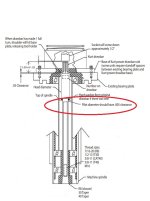The washer just goes on the drawbar when you stick it in.
With the drawbar removed the collet should go in by hand to full seat. (When aligned with the key).
It is just a long bolt and nut assembly. When tight there should be no up/down going on if the quill is not moving.
The washer serves to not chew up the back end of the spindle when you tighten it.
While the same looking there are different length bolts (drawbars) used for different machines. Sometimes you cut to fit.
When I said blue I meant remove the drawbar and blue it then stick in and tighten. (you can use grease).
Make sure it has clear threads past the tight point and screw your collet onto it by hand past this point looking for bind.
Again, just think bolt and nut holding something together. The bolt is the bar, the nut is the collet.
Some runout up top is normal but yours is maybe a bit high. That is a bent bar but these still usually hold just fine and the socket has a ton of sideways play.
I have never had one of your machines but have had a lot of B-ports and power drawbars.
Most common failure is the vanes in the impact go bad and it does not make enough power.
Lack of air pressure to it being right behind as number two. (bad fittings, bad regulators, etc)
These show up as spun tools or endmill pull out, not a drop out of the collet so I am so very confused.
The impact up there also has a up/down air cylinder and slide which may get sticky. It has to go up and be free in space.
Make sure this part works.
If it touches the bar during running that will be bad. If you are in forward and the socket up top holds the bar a bit what happens?
Whine noise up top?
Bob
(sorry for long post, curious and still learning)



